Rock climbing, a healthy sport activity but requires the physical strength of the person who wants to experience this form. Have you ever heard of volcanic climbing? Climbing a volcano is not as simple as we think because it requires a license issued months in advance, climbing techniques and a paid fee for an instructor. It's too difficult, right, so to simplify, we just need to drive to the volcano we want to visit or walk up a nearby hill for easy observation. The places below will be a suggestion if you want to try what it is like to climb a volcano.
1 Eyjafjallajokull Glacier Volcano, Iceland

the volcano in the Eyjafjallajokull glacier is spewing white smoke. Source: arctic adventures
The volcano in the Eyjafjallajokull glacier was filmed in 2010
This long yet challenging hike takes you through stunning landscapes including snow, ice, and ash from the most recent volcanic eruptions. Start your journey to the top of the mountain through a glacier with many fissures, where you can see the huge crater, the remnants of which were left behind by previous eruptions. Glacier walking devices such as crampons (an assistive device attached to footwear to improve mobility on snow and ice) are required. If you happen to reach the top of the mountain on a clear day, you can observe half the island consisting of glaciers, volcanoes, and the Vestmannaeyjar archipelago. From May 4 to September is the time to experience a sense of adventure, like skiing. The climb can last anywhere from 8 to 10 hours, although challenging, but you will definitely find yourself on top of the world at this glacier volcano.
2 Arenal Volcano, Costa Rica
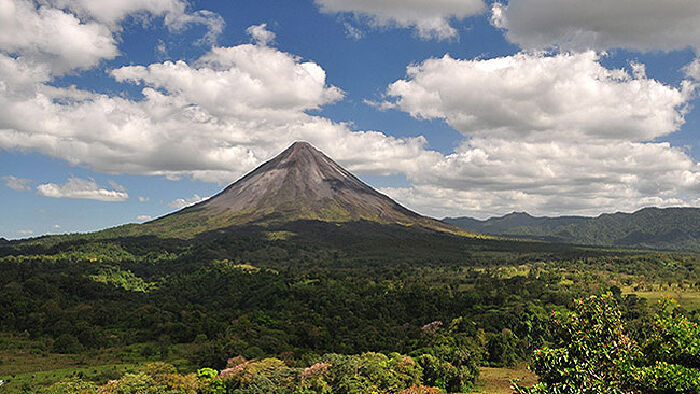
The Arenal volcano is quite symmetrical in shape. Source: costa rica vacations
Discovery of Arenal Volcano
Arenal was one of the most active volcanoes from about 1968 to 2010, since then activity has slowed but it still spews ash and sometimes lava. It has a classic shape, tall and quite proportional. You can't climb to the top of this volcano because it's illegal and very dangerous, but luckily there are a few worthwhile hikes that are perfectly legal and still get you up to Arenal. Inside the Arenal Volcanic National Park, with a length of about 5 km, will take you through the rainforest, you will have the opportunity to see the peak of the mountain. A lot of wildlife that you can observe includes Toucan birds (members of the family Ramphastidae include finches from the Neotropics) and monkeys. Walking through the old lava flows, you can also hear the "breathing" of the volcano, which is actually quite impressive.
3 Mt. Fuji, Japan
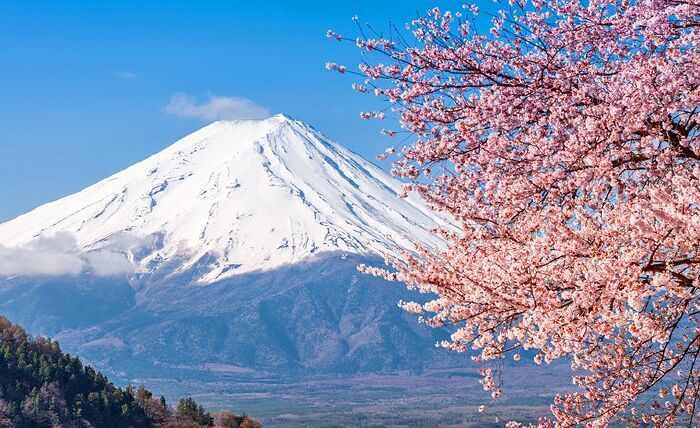
Mount Fuji is brilliant in spring. Source: planetware
Mt. Fuji Climbing Experience
It is the highest peaked volcano in Japan, where tourists and locals regularly climb here to observe (more than 200,000 people per year, to be exact), called one of the three Holy Mountains (3 holy mountains in Japan including Mount Fuji, Mount Haku and Mount Tate). The last eruption of Mount Fuji occurred in 1707, and the ash spread as far as Tokyo, forming a new crater on the eastern flank. From July to September is the official climbing season, trails and climbing facilities are again open to visitors. The most popular way to climb this volcano is to climb halfway to rest in the huts, set off again in the night, and reach the summit to watch the sunrise. Sun worship at the top of a mountain is a form of spirituality, regardless of whether you are religious or not. You can't avoid the crowds here, with some even claiming that climbing between multiple like-minded people adds to the overall experience.
4 Volcano Etna, Sicily
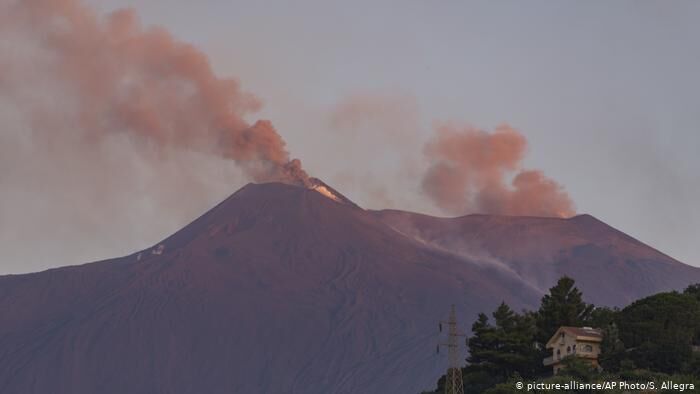
Etna volcano with its red smoke. Source: DW
Active Etna volcano recorded in February 2020
As the largest active volcano in Europe, Etna is often surrounded by fog and steam. Mount Etna is unique in that it has a unique relationship with the people who live at the foot of the mountain. They believe that Etna brings fertile soil by spewing lava, so respect must be given because it can also take life. This volcano can be climbed year-round and does not require any kind of permit or guide, but you should be informed of its operating status for hikers. Plan now to observe the frozen lava river, good visibility, unrestricted provided that the peak is not covered by clouds.
5 Pacaya Volcano, Guatemala
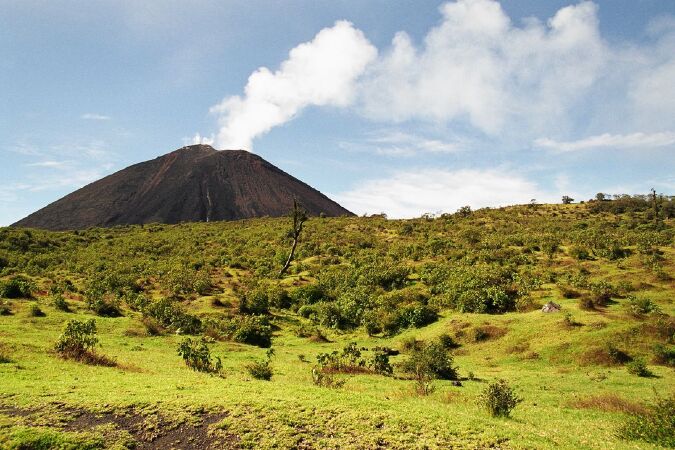
View around Pacaya volcano. Source: iexplore
red lava flows from the Pacaya volcano
You are absolutely not allowed to ascend to the top of this volcano but there are still some reasons that it is on the list of best climbing places. First, the trip can be done in half a day, which makes it perfect for backpackers. Secondly, in addition to the active volcano, you can also see the second active volcano nearby, and the third is now a crater lake. Past the verdant foliage there are views of the fields and surrounding hills. The trail eventually turns into lava and dust rock, which is quite slippery. You have to pay a fee to buy a cane. At the "top" the lava is literally flowing and you will clearly see why shoes with good soles are needed because otherwise they will melt under the intense heat. Marshmallows and sausages can also be cooked under high heat from lava.
6 Volcano Vesuvius, Italy
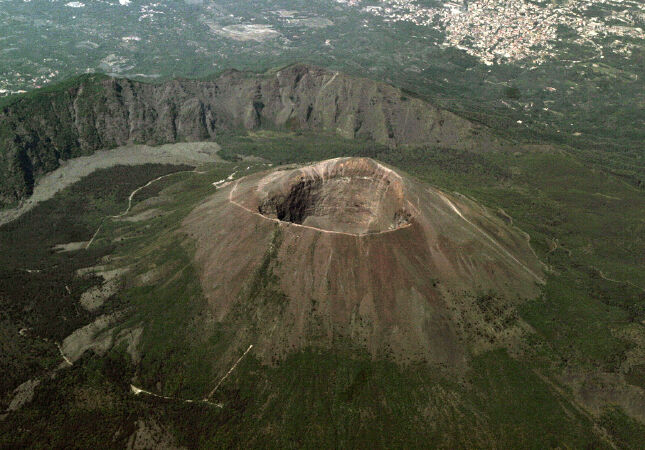
Mount Vesuvius seen from above. Source: Britannica
eruption process of Mount Vesuvius
This volcano is known worldwide for covering the city of Pompeii with a layer of ash in 79 AD, after which it preserved this condition until it was rediscovered in the 1700s. Since that time, the volcano has erupted more than 30 times throughout its history, most recently in 1944. This is the easiest mountain to climb on the list, taking only about 30 minutes. It is best to wear hiking shoes or running shoes, without carrying any equipment with you. What awaits you is a beautiful view of the whole city, the islands and part of the Apennine Mountains. The tour includes having a guide to the crater that many people may not know about. You won't find lava spewing out but will often see water vapor rising from the crater. On a sunny day, visitors can observe the view of the Bay of Naples. If you are looking to climb a famous volcano and don't want to worry then this is one of the mountains you should choose.
7 Pinatubo Volcano, Philippines

Pinatubo volcano with a clear blue lake at the crater. Source: go philippines - blogger
observation of Pinatubo volcano from above
This active volcano is located on the Philippine island of Luzon, which last erupted in 1991, producing one of the most violent eruptions of the 20th century. Currently, it is quite quiet, this is the ideal time to climb to the top, enjoy the clear blue crater lake. January 1 is quite suitable for traveling because the temperature is at its coolest and the lake color is also the most beautiful. It's really easy because there's already a 4X4 pickup truck that takes you through part of the way. The trip is made within a few hours with a moderate inclination. If you want, you can set up a tent on the top of the mountain and stay overnight, even serving accommodation. For hikers, they will cross sandy cliffs and small indigenous tribes to reach the top.
8 Kilauea Volcano, Hawaii
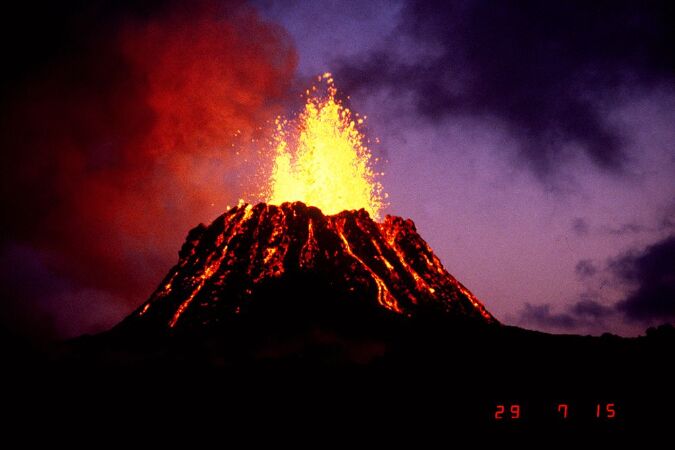
active Kilauea volcano. Source: live science
intense lava flows of Kilauea volcano
Located on the Big Island, Kilauea is the world's most active volcano and one of the most accessible. In the twentieth century alone, this volcano erupted 45 times with the most recent eruption beginning in 1983. To date, this eruption continues and has shot out more than 32 billion cubic yards of lava, altering the region's landscape forever. You can actually drive into this volcano, but walking is more recommended. Walking around Crater Rim Drive (an 11-mile trail that runs along the edge of Kilauea volcano in Hawaii's Volcanoes National Park) is one of the most popular activities as you can witness lava oozing from the volcano, vents, and lands just a few days old. There are many hiking trails, and helpful guides at the visitor center will point you in the right direction.
9 Stromboli Volcano, Aeolian Islands

panoramic view of the Stromboli volcano.Source: pinterest
observation of the eruption of the Stromboli volcano
This volcano only allows guided walking and strict limits on the number of people allowed to visit the crater each day, so reservations are recommended if you want to visit. The climb is not for the faint of heart, it will take two to four hours to reach the top. The most common time to reach the summit is at night, so many tours depart around 4pm. At first, a path with a slight inclination looms, taking you through lush vegetation. It quickly becomes steeper and you have to walk through volcanic sand strewn with black rocks. There are actually three craters at the top that emit steam and smoke, making a strange humming sound. The light show was what everyone was waiting for as the crater exploded with fiery red sparks, shooting into the air.
10 Bromo Volcano, Indonesia

majestic landscape around Bromo volcano. Source: intrepid travel
hiking to see the Bromo volcano
Indonesia is home to more than 100 active volcanoes and earthquakes occur daily, making it a popular location for challenge enthusiasts and hikers alike. Although Mount Bromo is not the highest of the active volcanoes in Indonesia, it is the most visited and quite easily accessible. The volcano has continuous puffs of white smoke, as if waiting to explode at any moment. Climbing to the top is also quite easy without a guide, it is best to choose the right time to watch the sunrise, which means you need to wake up at 3am, take an hour or so to hike to the top. An interesting fact about this volcano is that the Tengger people believe that in order to appease the gods here, they must make offerings of food and money by throwing it into the crater during the annual Kasada festival.
11 Cotopaxi Volcano, Ecuador
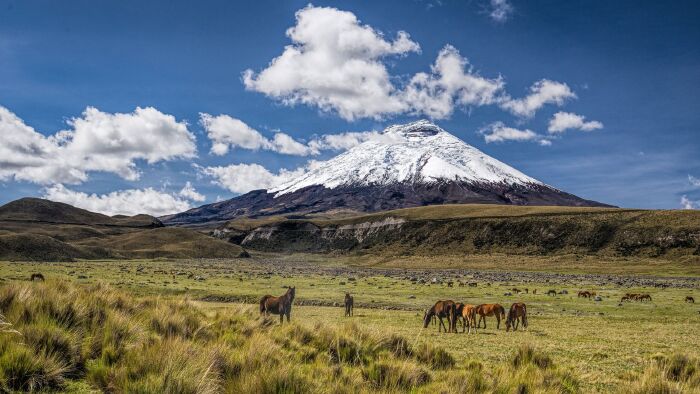
Mount Cotopaxi is covered with white snow. Source: andBeyond
climb the active Cotopaxi volcano and cycle down the mountain
It is the second highest peak in Ecuador, it has a cone shape with white snow cover. The climb is not for inexperienced hikers. In the eighteenth and nineteenth centuries, this volcano had a violent storm but now it is almost just a plume of water vapor rising from the top, melting around its glacier. To get there, most climbers have to take a 4X4 car to the park border. Then they went with their guide to a mountain hut and stayed overnight, continuing their conquest the next morning. Climbing mountains without an instructor is now illegal because of the signs of recent eruptions that are dangerous. If given the chance, conquering the third highest active volcano in the world is definitely something you should include in the list.
12 Pelee Volcano, Martinique
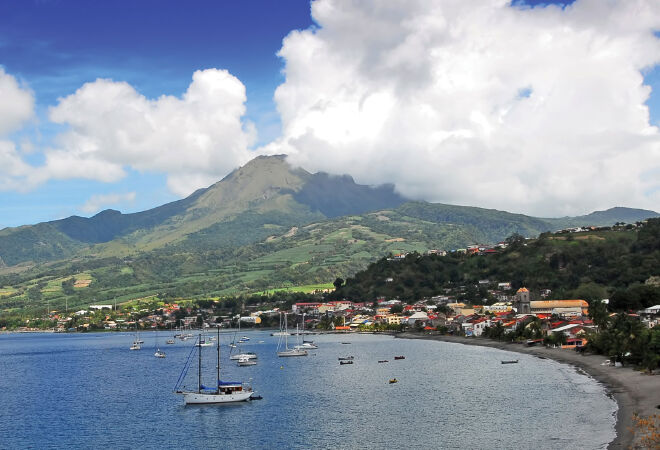
Pelee volcano with beautiful views. Source: britannica
in the past the Pelee volcano claimed thousands of lives
In 1902, this powerful volcano erupted and destroyed the entire town of St. Pierre killing about 30,000 people. Luckily since then it has been possible to climb this volcano without worries. Climbers do not need to pay fees or red tape (complicated administrative procedures) but need to know French because English is not widely spoken. Due to the vast vegetation on the island, there are three established routes for hikers. The most popular of these is Aileron Road as it is a well-constructed road. It is recommended to climb the mountain before dawn as the clouds roll day after day, limiting the view of the magical views that await. Beautiful lush green vegetation with flowering plants, jagged peaks will surprise visitors.
13 Telica Volcano, Nicaragua

Telica volcano has relatively flat terrain. Source: wander with wonder
climbing the Telica volcano at sunset
Nicaragua has so many volcanoes, both dormant and active, it's hard to choose which one to climb but it is recommended to head to Telica. Much of the climbing trail is relatively flat, passing through farmland. It takes about an hour or two to start climbing to the top. The best season to climb this mountain is controversial as the dry season tends to be hot while the rainy season can make lava harder to witness. Camping on top of Telica is one of the most popular forms of lava observation at night, and the morning sunrise is truly breathtaking. Lava is located beneath the crater rim at a depth of about 120 meters, you should lie on your stomach to see into this crater.
14 Aso Volcano, Japan
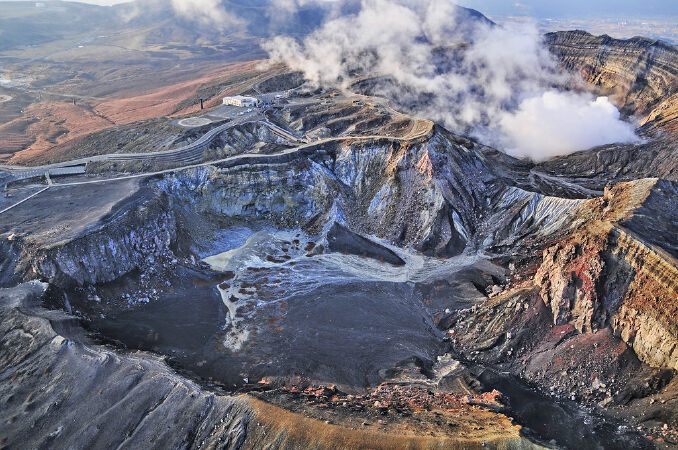
sulfuric gas gushed from the Aso volcano. Source: flickr
recorded volcano Aso erupting in November 2019
This is Japan's largest active volcano, which is sure to be an adventure that should be at the top of your list. There are three trails you can use to get to the top, one of them doesn't actually lead to the volcano (hint: don't take the trail on the left). The hike itself can take anywhere from an hour or three depending on which trail to choose and how many stops you rest at along the way. There are actually five separate volcanic peaks here, and Nakadake Peak is the most active peak that spews a continuous stream of sulfuric gas. If you still want to get to the top of the volcano without the hassle of walking, the cable car is a reasonable choice for you.
15 St Helens Volcano, U.S.

St Helens volcano with many dangers from ice and loose boulders for hikers. Source: bloomberg
St Helens volcano with widespread destruction when active
A permit is required to hike up this active volcano, regardless of the time of year, and only a few permits are issued each year if you want to reach the top of the crater. Although specialized climbing techniques are not required, it is strenuous and has potential hazards such as ice, loose boulders and fast-changing weather. The view at the top is described as "surreal, incredible and inspiring". A huge crater with a dome that grows every year, with horseshoe-shaped glaciers all around, not to mention the amazing nature of Mount Adams, Mount Hood and Mount Rainier, and the green hills that surround them are all perfect sights. This is truly one of the best climbing places in the world that should be at the top of your climbing list.

